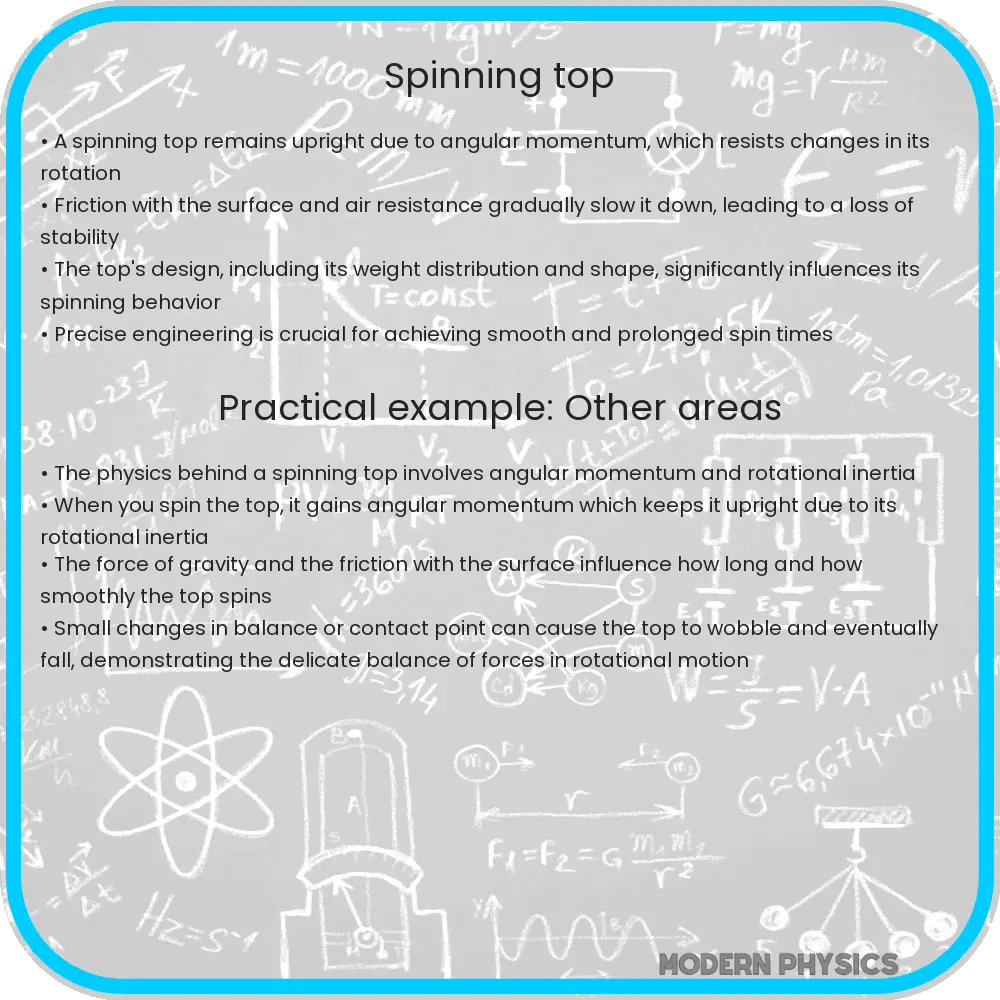Explore the physics of spinning tops, delving into stability, momentum, kinematics, and their real-world applications in this comprehensive guide.

Understanding the Physics of Spinning Tops
The spinning top, a toy familiar to many cultures worldwide, exhibits fascinating physics principles. Its stable, seemingly magical motion is governed by concepts from stability, momentum, and kinematics.
Stability of a Spinning Top
One of the most intriguing aspects of a spinning top is its ability to maintain an upright position during motion. This phenomenon is largely due to the gyroscopic effect, which arises from the conservation of angular momentum. Angular momentum, a vector quantity, is conserved in a spinning top, meaning the direction of its spin axis tends to remain constant unless acted upon by an external torque.
As the top spins, it creates a gyroscopic effect, providing stability. This stability is a balance between gravitational force pulling down on the top’s center of mass and the centrifugal force due to its spinning motion. The faster the top spins, the greater the gyroscopic effect, and the more stable the top becomes.
Momentum and Precession
Angular momentum (\( L \)) in a spinning top is given by \( L = I \omega \), where \( I \) is the moment of inertia and \( \omega \) is the angular velocity. The moment of inertia depends on the mass distribution of the top. A top with most of its mass concentrated at the rim will have a higher moment of inertia compared to one with its mass near the axis, resulting in different spinning behaviors.
Precession is another critical aspect of spinning top dynamics. When a force, such as gravity, acts to change the direction of the top’s angular momentum, the top doesn’t fall over immediately but instead begins to precess. This precession is a slow, circular motion of the spin axis and is perpendicular to the direction of the applied force. The rate of precession depends on the top’s angular velocity and its moment of inertia.
Kinematics of Spinning Tops
Kinematics, the study of motion without considering the forces that cause it, also plays a vital role in understanding spinning tops. The top’s motion can be described in terms of translational and rotational kinematics. Translational motion refers to the movement of the top’s center of mass, while rotational motion involves the spinning around its axis.
The top’s angular speed, direction, and rate of precession are key aspects of its rotational kinematics. These factors change over time due to frictional forces, such as air resistance and the friction at the point of contact with the surface, gradually slowing the top’s spin and affecting its stability.
Understanding these intricate physics principles not only demystifies the operation of a simple toy but also provides insights into more complex rotating systems in the natural and technological world.
Energy Considerations in Spinning Top Motion
The behavior of a spinning top is also influenced by energy transformations. Initially, the energy is input manually (through spinning the top), converting potential energy into kinetic energy. The top’s kinetic energy is divided into translational kinetic energy (due to its movement across a surface) and rotational kinetic energy (due to its spinning motion).
Over time, frictional forces, including air resistance and the friction between the top and the surface it spins on, gradually convert this kinetic energy into heat, slowing the top down. This energy dissipation is what eventually causes the top to lose its stability and fall over.
Mathematical Modeling and Real-World Applications
Mathematically modeling the motion of a spinning top involves solving complex differential equations. These equations take into account the top’s geometry, mass distribution, initial spin velocity, and external forces like gravity and friction. Engineers and scientists use similar principles in designing gyroscopes and stabilizers found in various applications, from smartphones to spacecraft.
Gyroscopes, similar in principle to spinning tops, are crucial in navigation systems for ships, aircraft, and spacecraft, providing stability and orientation control. The same principles allow smartphones to detect orientation changes for screen rotation and are integral in advanced camera stabilization systems.
Conclusion
The humble spinning top, a toy that has entertained generations, is a gateway to understanding complex physics concepts. Its motion encapsulates fundamental principles of stability, momentum, and kinematics, offering a tangible example of these theories at work. The study of spinning tops not only enriches our understanding of physical laws but also connects us to real-world applications in technology and engineering. By exploring the elegant dynamics of this simple object, we gain insights into the sophisticated world of rotational motion and its critical role in modern technology.
In essence, the spinning top is not just a toy but a miniature laboratory for physics, demonstrating the harmonious interplay of forces and motion that govern our universe. It’s a perfect example of how play and learning can intertwine, revealing the profound within the playful.
